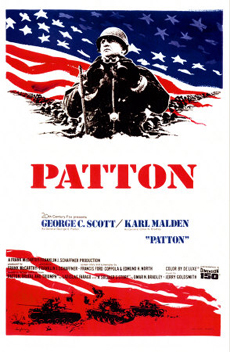The movie starts with perhaps the most famous scene of the movie, where
Patton stands in front of a huge American flag, speaking to an unseen
audience, giving them a pep talk before battle. The speech gives viewers
a sense of who Patton is, as well as what's at stake in the battle,
as he urges his men to be tough and unyielding, not to give in to fear.
He expresses these thoughts through very salty language. Incidentally,
this speech comprised actual Patton quotes, although he didn't string
them all together in one long speech.
It's interesting to note that Scott was unaware the film would start
with this speech but thought it would come closer to the end of the
film. Scott told the director that if the film started with this speech,
he'd never be able to live up to it in the rest of the film, so the
director lied and told him it would come later. Schaffner's instincts
were correct: it was a good way to introduce viewers to Patton and his
way of thinking and leading.
As portrayed in Patton, the famous general is a sometimes ruthless
but more often strategic commander, who believed he had a destiny to
fulfill and railed against anyone who stood in his way. Throughout the
war, he engages in a contest with General Montgomery to see who can
lead their men to the most glory. This means taking on tough battles
and capturing key strategic sites. Patton was known by the nickname
"Old Blood and Guts," because of the often costly results
of his plans.
Lest anyone think he didn't care about the dangers faced by his men,
we see Patton writing a heartfelt condolence letter to the mother of
a fallen soldier, as well as visiting troops in a field hospital. Of
course, when he sees somebody in the field hospital he believes should
not be there, his strong reaction leads to political repercussions.
The real Patton was controversial, not always understood by his contemporaries.
In fact, it's been said that, with his quirks, he might not have been
promoted so high, except that he was effective. This film explores what
drove him. At times he seems driven only by his own glory; yet, he understands
strategy better than almost any other allied general.
Scott did an incredible job, showing us many dimensions of this character,
instead of portraying him as a pompous egomaniac. He shows us a sensitive
side: a man who quotes and reads poetry, who believes in past lives
and a spiritual destiny. To convey these different sides, Scott makes
good use of facial expressions and body language. He won an Oscar for
his portrayal but refused to accept it, saying that he did not feel
himself in competition with his fellow actors, calling the Oscars a
"meat parade." The film's producer accepted the award on his
behalf but returned it the next day in accordance with Scott's wishes.
Karl Malden does a good job as General Omar N. Bradley, the so-called
"G.I. General," a down-to-earth counterpart to Patton. Bradley
is not flashy, not consumed with ideas of grandeur. Instead, he is practical
and steady.
Producer Frank McCarthy contributed to the authenticity of the film,
as he was a retired brigadier general who had served on the staff of
General George C. Marshall during World War II. Nearly half the budget
was spent on soldiers and equipment which were rented from the Spanish
army. Some actual war footage was used in the film, shot by future director
Russ Meyer, who was a combat cameraman.
Also adding to the authenticity were vintage tanks. The American and
British tanks were M-24 "Chaffee" light tanks. A different
type of American tank was used for the German tanks. Ironically, they
were postwar M-47 and M-48 tanks, both of which are called "Patton"
tanks.
This was a perfect movie to watch on Memorial Day weekend, as a reminder
of the conditions that the military faced during World War II and the
sometimes complicated personalities of the people who led them.


